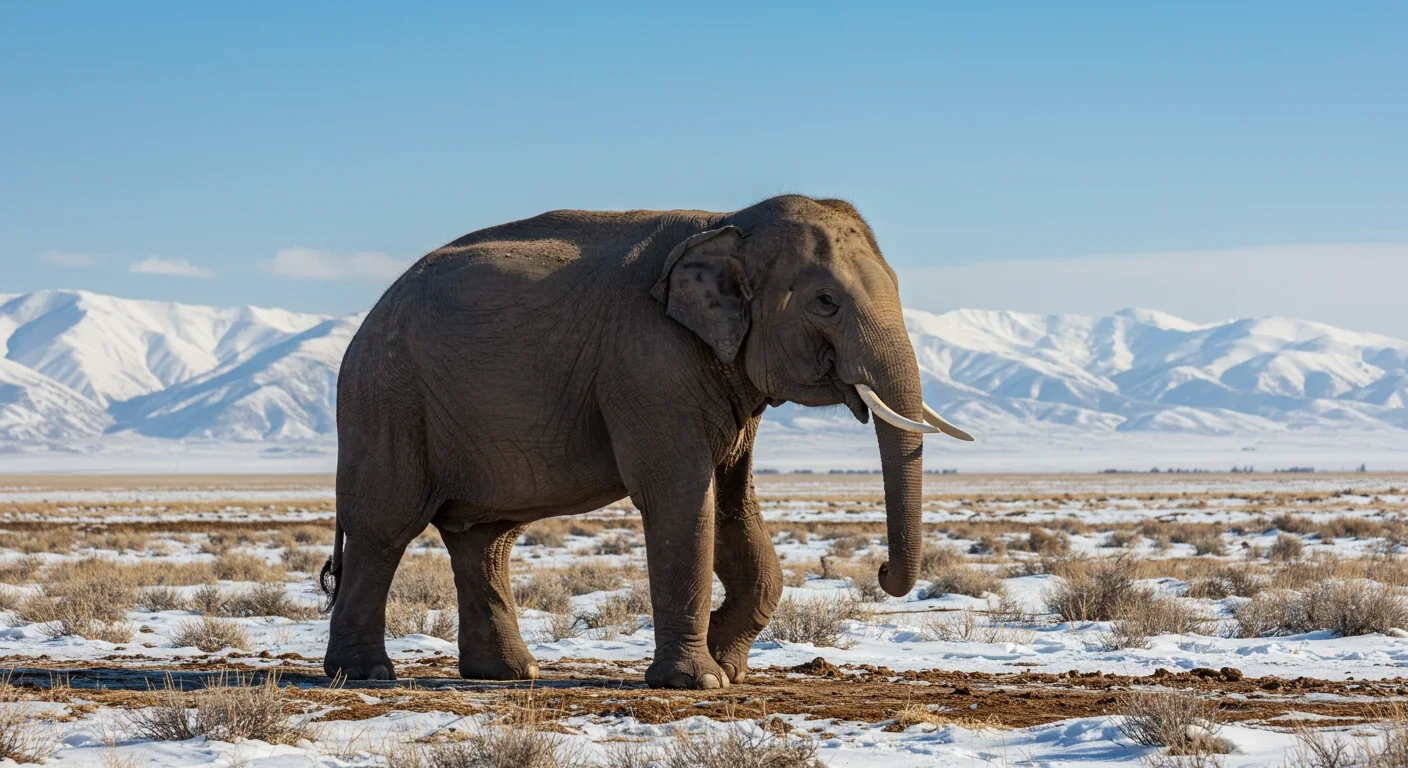Bombardier Beetle Chemical Defense: Nature's Micro Engine

TL;DR: Scientists use CRISPR to resurrect traits from extinct species like mammoths and dire wolves, creating genetic hybrids. But billion-dollar de-extinction projects raise urgent questions: Should we resurrect the dead when living species need saving now?

In a Dallas laboratory, researchers have created "Chip and Dale"—the world's first woolly mice. These small, fuzzy creatures represent more than a scientific curiosity. They're proof that the genetic ghosts of extinct species can be summoned into living flesh. With CRISPR gene editing, scientists inserted traits from the long-extinct woolly mammoth into ordinary mice, giving them thick, insulating fur suited for Arctic cold. It's a small step, but it hints at something profound: we're learning to resurrect the dead.
The question isn't whether we can bring back lost species anymore. The question is whether we should.
Synthetic biology has handed us an unprecedented toolkit. CRISPR-Cas9 allows scientists to edit genes with molecular precision, rewriting the code of life itself. Gene synthesis lets researchers build DNA sequences from scratch, crafting genetic material that hasn't existed for thousands of years. When combined with cloning technology and a deep understanding of genomics, these tools make what once seemed impossible—bringing extinct species back to life—tantalizingly within reach.
But here's the catch: we're not really bringing back the extinct. We're creating something new.
Take the dire wolf project announced by Colossal Biosciences in early 2025. The company claimed to have "proudly returned the dire wolf to its rightful place in the ecosystem." Sounds impressive until you dig into the details. What they actually created was a modern grey wolf with about 20 genetic edits—modifications to 14 genes that made the animals roughly 20% larger than typical wolves. The result: animals that weigh over 40 kilograms by six months, compared to the average wolf's 33 kilograms.
These engineered wolves carry only a tiny fraction of actual dire wolf DNA. They're hybrids, approximations, echoes of something that once existed. And this pattern repeats across the field. The woolly mammoth project aims to edit Asian elephants with subcutaneous fat, woolly hair, and sebaceous glands. The dodo revival effort plans to modify rock pigeons with dodo traits. In each case, scientists are creating functional analogs, not perfect replicas.
The ecological argument for de-extinction sounds compelling at first. Extinct species once played crucial roles in their ecosystems—roles that remain empty today. Woolly mammoths, for instance, grazed across the Arctic tundra, trampling dead grass and increasing the landscape's albedo, which helped keep permafrost frozen. Proponents argue that mammoth-like elephants could slow tundra warming by recreating these effects, potentially mitigating climate change impacts in northern regions.
The passenger pigeon, which once darkened North American skies in flocks numbering billions, shaped forest ecosystems through its feeding and nesting behaviors. Its extinction left gaps in seed dispersal and forest regeneration patterns. Bring it back, the reasoning goes, and you restore ecological balance.
But critics aren't buying it. The practical obstacles are staggering. Creating even one mammoth-elephant hybrid requires editing dozens of genes in elephant embryos—a process that's technically demanding, expensive, and ethically fraught. Then you need to gestate the embryo in a surrogate elephant mother, wait 22 months for birth, and hope the offspring survives the health complications that plague cloned and heavily edited animals. Many cloned animals suffer premature deaths and chronic health issues, a pattern that doesn't inspire confidence.
Even if you succeed in creating a handful of healthy animals, that's just the beginning. To have any ecological impact, you'd need breeding populations—hundreds or thousands of individuals spread across suitable habitat. The timeline stretches across decades. The costs balloon into billions. And all the while, the clock keeps ticking for species that are endangered now, not extinct.

Let's talk about money, because the economics of de-extinction are eye-watering. Colossal Laboratories reportedly spent over $10 billion engineering just three dire wolf analogs. Ten billion dollars. For comparison, the entire global budget for biodiversity conservation in 2024 was estimated at around $52 billion. A single de-extinction project consumed nearly 20% of the world's annual conservation spending.
This raises an uncomfortable question: what if we invested that money in protecting living species instead?
The IUCN Red List currently identifies more than 44,000 species as threatened with extinction. Many could be saved with relatively modest interventions—habitat protection, anti-poaching enforcement, pollution control, invasive species management. For $10 billion, conservationists could protect vast swaths of habitat, employ thousands of rangers, and fund breeding programs for hundreds of endangered species.
Critics argue that de-extinction creates a dangerous moral hazard. If we can bring species back after they're gone, what's the urgency in protecting them now? The very existence of de-extinction technology could weaken political will for conservation, giving governments and industries an excuse to delay action. "Don't worry about habitat loss—we can always resurrect species later with CRISPR" becomes a convenient rationalization for environmental destruction.
There's also the question of priorities. De-extinction projects tend to focus on charismatic megafauna—mammoths, dire wolves, dodos. These species capture public imagination and media attention, which helps companies like Colossal Biosciences attract investment. But from an ecological perspective, are these the species we should prioritize? What about the thousands of less photogenic species—insects, fungi, plants—that play equally critical roles in ecosystem function?
The ethical landscape of de-extinction is Byzantine. Let's start with animal welfare. Creating a mammoth-elephant hybrid involves extensive genetic manipulation of elephant embryos. The resulting animals would be evolutionary novelties—creatures with no species identity, no natural social group, no inherited behaviors adapted to their genetics. How do you teach a mammoth-elephant to be a mammoth when no mammoths exist to learn from?
Then there's the consent issue with surrogate mothers. An elephant carries a pregnancy for nearly two years—an enormous physiological burden. Are we justified in subjecting endangered Asian elephants to the risks of gestating experimental hybrids? What happens if the pregnancy fails, or if the hybrid offspring is born with severe abnormalities?
And here's where things get really weird: some researchers have speculated about using CRISPR to resurrect extinct human ancestors like Neanderthals or Denisovans. The technical barriers are immense, but they're not insurmountable. If we can edit elephant genes to add mammoth traits, the same principles could theoretically apply to editing human genes to add archaic hominin traits.
The ethical implications are staggering. Would a resurrected Neanderthal have human rights? Who would raise them? What would their legal status be? These aren't abstract philosophical questions—they're practical concerns that bioethicists are already grappling with.
Here's a danger that doesn't get enough attention: engineered organisms could function as invasive species.
When you create a mammoth-elephant hybrid or a dire wolf analog, you're creating something that has never existed in evolutionary history. These organisms have no natural predators, no established ecological niche, no evolutionary relationships with existing species. Release them into the wild, and they become ecological wild cards.
Even if researchers plan to keep them confined, escape risks are never zero. Studies on invasion biology show that engineered organisms, even those carefully contained, carry some probability of escape. Once out, their impacts become unpredictable. A dire wolf analog might outcompete existing wolves, disrupt prey populations, or introduce novel parasites and diseases.
The IUCN has developed frameworks for assessing invasion risk from engineered species, but these protocols are untested at scale. We're essentially flying blind, hoping that our engineered creations won't trigger unintended ecological cascades.

Different regions approach de-extinction with starkly different attitudes. In the United States, venture capital–funded companies like Colossal Biosciences drive the field, motivated by profit potential and media attention. The regulatory environment is permissive, with limited federal oversight of genetic engineering in animals beyond agricultural contexts.
Europe takes a more cautious stance. Regulatory frameworks tend to prioritize precautionary principles, requiring extensive risk assessment before releasing genetically modified organisms. There's greater emphasis on public consultation and democratic decision-making about biotechnology applications.
In countries like Australia, where introduced species have caused catastrophic ecological damage, there's acute awareness of invasion risks. Australian researchers working on genome editing for conservation focus primarily on strengthening threatened native species rather than resurrecting extinct ones.
Meanwhile, developing nations with rich biodiversity face different pressures. Brazil's biotech sector, for instance, grapples with balancing conservation needs against economic development, often with limited resources for either traditional conservation or advanced biotechnology.
This fragmentation creates problems. If de-extinction becomes feasible, who decides which species get priority? Who sets the standards for ecological risk assessment? Without international coordination, we risk a patchwork of conflicting regulations and ethical standards.
Here's the irony: the same synthetic biology tools being developed for de-extinction could revolutionize conservation of living species—if we redirect them.
Gene editing is already being used to strengthen threatened populations against disease. Researchers are working on making amphibians resistant to the chytrid fungus that's driving global amphibian declines. They're engineering coral with heat tolerance to survive ocean warming. They're developing genetic tools to control invasive species like rats and mosquitoes that threaten island ecosystems.
These applications don't have the sexy marketing appeal of resurrected mammoths, but they address real, urgent conservation challenges. A disease-resistant frog population saves a species from extinction now. Heat-tolerant coral preserves reef ecosystems that support thousands of other species. These are practical applications with measurable conservation benefits.
The technology developed for mammoth de-extinction—techniques for cell culture, embryo manipulation, gene editing—could accelerate these practical applications. The problem is that de-extinction captures funding and talent that could flow toward more impactful work.
Perhaps the most concerning aspect of current de-extinction efforts is the lack of oversight. Private companies like Colossal operate with minimal independent ethical review. They're not required to publish their methods in peer-reviewed journals. They face no mandate to conduct ecological impact assessments before releasing engineered organisms.
This creates a governance gap. De-extinction raises questions that transcend national borders—questions about ecological risk, animal welfare, resource allocation, and the very definition of nature. These issues demand international dialogue and coordinated regulation.
Some experts call for an international body, similar to those governing nuclear technology or climate policy, to oversee de-extinction research. Such a body could establish ethical standards, require ecological risk assessments, mandate transparency, and ensure public participation in decision-making.
Without this kind of governance, we're left with a technological frontier driven primarily by private profit and public fascination, with limited accountability to broader societal interests.
The technology will continue advancing. Gene editing will get cheaper, faster, more precise. The technical barriers to creating mammoth-elephant hybrids or dodo-pigeon analogs will gradually fall. Within a decade, we'll likely see more de-extinction announcements, more woolly mice and engineered wolves.
But technology advancing doesn't mean we're ready for its consequences.
The fundamental question remains: in a world where millions of species face extinction from habitat loss, climate change, and pollution, is resurrecting the already-extinct our wisest use of resources? Or are we indulging in spectacular science while the house burns around us?
There's a deeper question too, one that cuts to how we see ourselves in relation to nature. De-extinction positions humans as planetary managers, capable of correcting past mistakes through technological prowess. It's an optimistic vision, but also a hubristic one. It assumes we understand ecosystems well enough to engineer them, that we can predict and control the consequences of introducing novel organisms into complex ecological webs.
History suggests caution. Every time humans have confidently introduced species to new environments—rabbits in Australia, cane toads in Queensland, kudzu in the American South—the results have been ecological disasters. De-extinction multiplies this risk by orders of magnitude because the introduced organisms are entirely novel, with no evolutionary history to guide predictions.
Whether de-extinction proceeds or not, the conversation it's sparked matters. It's forcing us to clarify what we value in nature and conservation. Do we want wildness and evolutionary autonomy, or do we accept—even embrace—extensive human management of ecosystems?
These aren't just scientific questions. They're philosophical and political questions about the kind of world we want to live in and what we owe to other species.
For those watching this unfold, the key is staying informed and vocal. Demand transparency from companies pursuing de-extinction. Support conservation organizations working on proven, practical interventions for threatened species. Push for democratic governance of biotechnology, not just market-driven development.
And maybe most importantly, recognize that the rhetoric of de-extinction—the promise of undoing extinction, of technological salvation—can distract from the harder, less glamorous work of preventing extinction in the first place. Protecting habitat, reducing pollution, addressing climate change: these are the unglamorous necessities that will determine whether Earth's biodiversity survives the 21st century.
Woolly mice are impressive. But a living elephant, unmodified and wild, is even more so.

Recent breakthroughs in fusion technology—including 351,000-gauss magnetic fields, AI-driven plasma diagnostics, and net energy gain at the National Ignition Facility—are transforming fusion propulsion from science fiction to engineering frontier. Scientists now have a realistic pathway to accelerate spacecraft to 10% of light speed, enabling a 43-year journey to Alpha Centauri. While challenges remain in miniaturization, neutron management, and sustained operation, the physics barriers have ...

Epigenetic clocks measure DNA methylation patterns to calculate biological age, which predicts disease risk up to 30 years before symptoms appear. Landmark studies show that accelerated epigenetic aging forecasts cardiovascular disease, diabetes, and neurodegeneration with remarkable accuracy. Lifestyle interventions—Mediterranean diet, structured exercise, quality sleep, stress management—can measurably reverse biological aging, reducing epigenetic age by 1-2 years within months. Commercial ...

Data centers consumed 415 terawatt-hours of electricity in 2024 and will nearly double that by 2030, driven by AI's insatiable energy appetite. Despite tech giants' renewable pledges, actual emissions are up to 662% higher than reported due to accounting loopholes. A digital pollution tax—similar to Europe's carbon border tariff—could finally force the industry to invest in efficiency technologies like liquid cooling, waste heat recovery, and time-matched renewable power, transforming volunta...

Humans are hardwired to see invisible agents—gods, ghosts, conspiracies—thanks to the Hyperactive Agency Detection Device (HADD), an evolutionary survival mechanism that favored false alarms over fatal misses. This cognitive bias, rooted in brain regions like the temporoparietal junction and medial prefrontal cortex, generates religious beliefs, animistic worldviews, and conspiracy theories across all cultures. Understanding HADD doesn't eliminate belief, but it helps us recognize when our pa...

The bombardier beetle has perfected a chemical defense system that human engineers are still trying to replicate: a two-chamber micro-combustion engine that mixes hydroquinone and hydrogen peroxide to create explosive 100°C sprays at up to 500 pulses per second, aimed with 270-degree precision. This tiny insect's biochemical marvel is inspiring revolutionary technologies in aerospace propulsion, pharmaceutical delivery, and fire suppression. By 2030, beetle-inspired systems could position sat...

The U.S. faces a catastrophic care worker shortage driven by poverty-level wages, overwhelming burnout, and systemic undervaluation. With 99% of nursing homes hiring and 9.7 million openings projected by 2034, the crisis threatens patient safety, family stability, and economic productivity. Evidence-based solutions—wage reforms, streamlined training, technology integration, and policy enforcement—exist and work, but require sustained political will and cultural recognition that caregiving is ...

Every major AI model was trained on copyrighted text scraped without permission, triggering billion-dollar lawsuits and forcing a reckoning between innovation and creator rights. The future depends on finding balance between transformative AI development and fair compensation for the people whose work fuels it.